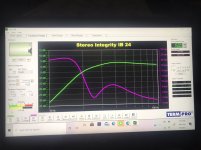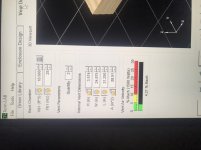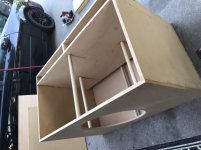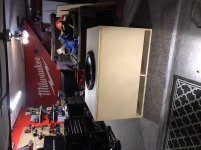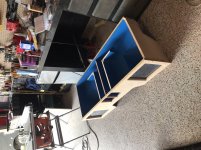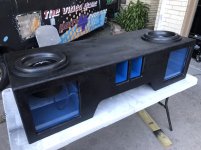Here it goes, my first post on the forum! 👍🏼☺️
My main question: does the box I built NEED more bracing to avoid a panel blowout? I’m ok with minimal panel flex but I can add more dowel rods to brace sides and front/back panels together.
I finished my 4th box build today. It’s definitely the biggest I’ve done at 28ft^3 gross volume. I enjoyed the process and I am very curious to learn more about building boxes of this magnitude as I have almost zero.
My big concern is bracing. I’ve never used it but I knew I needed to for this build I just didn’t know how much. For sure on the loaded panel to support the weight. But is there a mathematical way to figure out how stiff or rigid the panels should be? I’m currently going to school for mechanical engineering. I have an associate degree so far and almost done with undergrad classes so I can understand almost anything thrown at me no matter how technical. If I don’t get answers I’ll probably search my statics book and see if I can find a solution that I’ll share.
I want to be able to say ok the woofer is this “x” many inches and weights “x” lbs and will it be side/top/wedge mounted. How big is the panel it’s sitting in? What’s the material thickness? What’s the bracing material? Bracing thickness? ... use “this formula” to calculate amount of bracing for opposing panels and “this formula” for adjacent panels.
Not sure if I’m making this harder than it should be? how do you experienced guys do this process without unnecessarily over bracing your big boxes to maximize chamber volume but still keep a tight box that won’t flex or blow out a panel.
I’ll leave some pics of my project attached if anyone’s curious.
Any tips appreciated as I am fairly new to this and I want to learn how to build premium boxes!
This is a finished box but not “finished finished” the guy I built for said he wanted to rhino line on his own.
My main question: does the box I built NEED more bracing to avoid a panel blowout? I’m ok with minimal panel flex but I can add more dowel rods to brace sides and front/back panels together.
I finished my 4th box build today. It’s definitely the biggest I’ve done at 28ft^3 gross volume. I enjoyed the process and I am very curious to learn more about building boxes of this magnitude as I have almost zero.
My big concern is bracing. I’ve never used it but I knew I needed to for this build I just didn’t know how much. For sure on the loaded panel to support the weight. But is there a mathematical way to figure out how stiff or rigid the panels should be? I’m currently going to school for mechanical engineering. I have an associate degree so far and almost done with undergrad classes so I can understand almost anything thrown at me no matter how technical. If I don’t get answers I’ll probably search my statics book and see if I can find a solution that I’ll share.
I want to be able to say ok the woofer is this “x” many inches and weights “x” lbs and will it be side/top/wedge mounted. How big is the panel it’s sitting in? What’s the material thickness? What’s the bracing material? Bracing thickness? ... use “this formula” to calculate amount of bracing for opposing panels and “this formula” for adjacent panels.
Not sure if I’m making this harder than it should be? how do you experienced guys do this process without unnecessarily over bracing your big boxes to maximize chamber volume but still keep a tight box that won’t flex or blow out a panel.
I’ll leave some pics of my project attached if anyone’s curious.
Any tips appreciated as I am fairly new to this and I want to learn how to build premium boxes!
This is a finished box but not “finished finished” the guy I built for said he wanted to rhino line on his own.
Attachments
....more bracing to avoid a panel blowout?....
BLOWOUT??
Wooden boats ride 6 foot waves of WATER. Microns of air pressure won't blow-out any wood box the cat can't demolish.
Sound goes THROUGH walls, as you know. Mostly at a resonant frequency. Wall thickness adds mass and stiffness. Braces *may* add more stiffness than mass (thus raising the F; hope that it falls at a less-troublesome frequency). Mostly it is too painful to fully calculate (even bridge designers use shortcuts); Dave will know all of them.
Thanks for the input guys, and the aspect ratio tip!!
Yes I thought the same thing how could a panel blowout occur when the air mass is moving through 160 sq inches of port. I assumed if you could stabilize the applied load of the speaker with no flex in that panel then the box would be solid. The customer says he has seen a panel blowout happen. I don’t have any experience with this amount of power or speaker size nor have I heard a system with a speaker this big so I just got curious. But I’ll see how it holds up when he has it set up.
Here’s my last build to give you guys an idea of where I’m at more or less.
I look forward to contributing to this forum as much as I can and learning from you guys.
I already have my 5th box build lined up! I might record and start making videos but I feel like I don’t know enough to give thorough educational box build videos yet??
Yes I thought the same thing how could a panel blowout occur when the air mass is moving through 160 sq inches of port. I assumed if you could stabilize the applied load of the speaker with no flex in that panel then the box would be solid. The customer says he has seen a panel blowout happen. I don’t have any experience with this amount of power or speaker size nor have I heard a system with a speaker this big so I just got curious. But I’ll see how it holds up when he has it set up.
Here’s my last build to give you guys an idea of where I’m at more or less.
I look forward to contributing to this forum as much as I can and learning from you guys.
I already have my 5th box build lined up! I might record and start making videos but I feel like I don’t know enough to give thorough educational box build videos yet??
Attachments
BLOWOUT??
Blowout no, but balloon, yes. A big unbraced 19mm MDF box will balloon.
dave
How would you recommend I beef it up giving It’s already built... but has not been plugged up and tested. Cross bracing the 4 vertical walls to stiffen the box through its horizontal axis? How can I avoid making this mistake in the future? And would you recommend a different material other than 3/4 in MDF which is the thickest I can get my hands on locally.
So your saying recommend 2 18’s in an isobaric configuration to someone if they are interested in a 24” woofer for similar performance? I can try but the customer usually never listens lol.
So your saying recommend 2 18’s in an isobaric configuration to someone if they are interested in a 24” woofer for similar performance? I can try but the customer usually never listens lol.
I don't know about the mathematics of bracing (I'll leave that to your engineering classes). The way I think of bracing is to imagine each panel being like a speaker, flexing in and out. I would put the bracing in the middle of the points each panel flexes the most. So that would be the mid-point of the top/bottom. I would put three horizontally to brace the side panels. I would add a brace above and below the speaker to strengthen the front/back. All in addition to what you already have. But I've only braced lower-end speakers, I don't know if this would be over-doing it. To my knowledge, the firmer the box is the better the speaker will perform.
With regard to the wood, I would have chosen hardwood ply over mdf. You could strengthen the mdf by gluing panels of hardwood ply to the interior surfaces, this shouldn't change the interior volume too much.
With regard to the wood, I would have chosen hardwood ply over mdf. You could strengthen the mdf by gluing panels of hardwood ply to the interior surfaces, this shouldn't change the interior volume too much.
Cross bracing the 4 vertical walls to stiffen the box through its horizontal axis? How can I avoid making this mistake in the future?
Your cabinet is near 800 litres, to give you an example of the bracing required in a 135 litre box for a 16”. Start the brain moving.
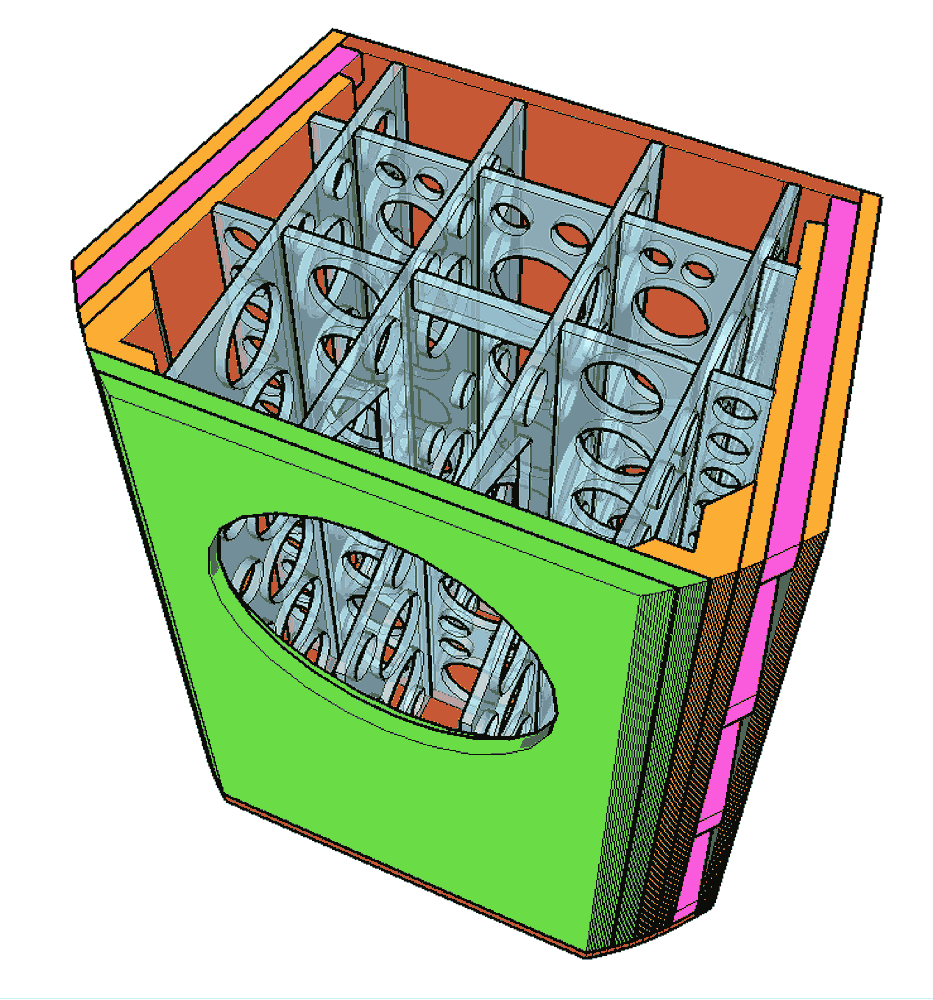
And would you recommend a different material other than 3/4 in MDF which is the thickest I can get my hands on locally.
15mm quality plywood be the first step up. 18mm is the usual choice with woofers, doubled where needed (baffles usually)
So your saying recommend 2 18’s in an isobaric configuration
Not isobarik, push-push. This uses the 2 drivers in such a manner that each driver’s reactive energy (the stuff that causes the box panels to move) dramatically reducing the box load.
a 24” woofer for similar performance?
Typically one looks at two d5s. rivers tha next size down. And there should be a much greater choice of 18” drivers. And even more 15”, even more 12s and 10s.
Also keep in mind that multiple subs are usually necessary to deal with room modes. If i wanted to move this kind of air i would look at 8 SDX10 in 4 push-push boxes properly arrayed across the room.

Example plans: http://www.planet10-hifi.com/downloads/TwinSDX10PPP-woof-230712.pdf
dave
I don't know about the mathematics of bracing (I'll leave that to your engineering classes). The way I think of bracing is to imagine each panel being like a speaker, flexing in and out.
A good description.
I would put the bracing in the middle
That is not a good placement. It will not suppress the primary resonce (i can find an illustration if needed).
dave
At the very least add a similar number of braces top to bottom as your front to back bracing. I'd also put bracing end to end. You can add a second skin with a constrained layer if you are disappointed with the initial result. Don't get too stressed about everyones' opinions; there are degrees of perfection.
Thanks everyone for the input. Rest assured I won’t be making bracing mistakes again lol. Or maybe I will but certainly not to this extent. I am a beginner after all. know I didn’t mention it and it can’t be seen well but their is a top layer of 3/4 birch ply making the top side 1.5 inches thick. I wish I did more research before building. A few window braces would have been good internally. Nonetheless I will brace it as much as possible without getting the internal volume screwed up and throwing off port tuning. It fit snugly in place in the van when test fitted so the van sides might be reinforcement enough for the internal sides to not have problems with resonance. I’ll update you guys when it’s braced more and tested. Thanks
-Chris
I searched panel resonance instead of subwoofer box bracing and found some good information from these sources.
Loudspeaker Cabinet Bracing: A Detailed Look on Do's and Dont's | Audioholics
Speaker Design: Driver-Induced Vibrations | audioXpress
-Chris
I searched panel resonance instead of subwoofer box bracing and found some good information from these sources.
Loudspeaker Cabinet Bracing: A Detailed Look on Do's and Dont's | Audioholics
Speaker Design: Driver-Induced Vibrations | audioXpress
And for anyone concerned about panel thickness...............
Double up or even triple up the mdf if thick stuff is not available. Or get crazy and have one layer of mdf laminated to one of good ply. As long as internal design volume is maintained the sky's the limit. But I have to admit, doubling 28mm mdf gets fearsome heavy.
Double up or even triple up the mdf if thick stuff is not available. Or get crazy and have one layer of mdf laminated to one of good ply. As long as internal design volume is maintained the sky's the limit. But I have to admit, doubling 28mm mdf gets fearsome heavy.
Would that introduce a possible problem of two layers interacting Dave? Two layers of ply or mdf I could imagine, would vibrate/rattle/flap against the other. Or does that happen? Maybe a sandwich of glue between would eliminate problems.Don’t replace, add another layer.
Correct. Any lamination of two casing layers must be fully glued. There may even be a benefit to using a rubbery mastic type of adhesive between the layers, the famous "constrained layers" idea. But this brings problems at the edges to hide the joins. On my Tarkus build I used two layers of 28mm MDF laminated using a full coating of polyurethane gel adhesive as the bonding agent. It is a mega strong material but when cured it stays ever so slightly soft, unlike epoxy or suchlike. Then even though the box is super rigid I braced side to side and front to back with 35mm dowels countersunk into the inner surfaces. It would be interesting to measure the panel vibration but I don't have any test equipment. Only my ears.
- Home
- Design & Build
- Construction Tips
- 24” subwoofer box bracing help
